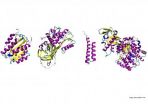(Press-News.org) ANN ARBOR, Mich. — A national shortage of critical care physicians and beds means difficult decisions for healthcare professionals: how to determine which of the sickest patients are most in need of access to the intensive care unit.
What if patients' electronic health records could help a physician determine ICU admission by reliably calculating which patient had the highest risk of death?
Emerging health technologies – including reliable methods to rate the severity of a patient's condition – may provide powerful tools to efficiently use scarce and costly health resources, says a team of University of Michigan Health System researchers in the New England Journal of Medicine.
"The lack of critical care beds can be frustrating and scary when you have a patient who you think would benefit from critical care, but who can't be accommodated quickly. Electronic health records – which provide us with rich, reliable clinical data – are untapped tools that may help us efficiently use valuable critical care resources," says hospitalist and lead author Lena M. Chen, M.D., M.S., assistant professor in internal medicine at the University of Michigan and an investigator at the Center for Clinical Management Research (CCMR), VA Ann Arbor Healthcare System.
The UMHS and VA study referenced in the article finds that patients' severity of illness is not always strongly associated with their likelihood of being admitted to the ICU, challenging the notion that limited and expensive critical care is reserved for the sickest patients.
ICU admissions for non-cardiac patients closely reflected severity of illness (i.e., sicker patients were more likely to go to the ICU), but ICU admissions for cardiac patients did not, the study found. While the reasons for this are unclear, authors note that the ICU's explicit role is to provide care for the sickest patients, not to respond to temporary staffing issues or unavailable recovery rooms.
A few integrated health care systems such as the Veterans Affairs (VA) Healthcare System and Kaiser Permanente Northern California have already tapped into the ability of electronic health records to generate reliable estimates of the risk of dying within 30 days for every patient on admission. This type of data could determine for instance whether a patient had a 3 percent chance or 80 percent chance of dying within the next month. Calculations are based on real-time data of laboratory results, demographics, coexisting conditions and vital signs. Authors note that this existing technology may be used to help assess ICU admissions.
"We are not suggesting this calculation be used alone in making these decisions but it's another tool that may – with more research – eventually help physicians making difficult triage decisions. It may potentially help address our critical care shortage too," says Chen, who is also a member of the U-M Institute for Healthcare Policy and Innovation.
ICUs were opened decades ago to care for the sickest patients using the newest technology. Today, critical care in the U.S. costs more than $80 billion a year. With an aging population and growing demand for critical care, the shortage of ICU resources has become a major healthcare issue.
There are other benefits for healthcare institutions that explore the role of health information technology in ICU care. The Medicare and Medicaid EHR Incentive Programs provide financial incentives for providers who show that they are "meaningfully using" electronic health records to improve patient care.
"There are serious incentives for hospitals to use electronic health records in a meaningful way and it's important to identify aspirational goals for health IT now, " Chen says. "We may not have the abilities to achieve all of these goals today, but it's important to put them in place to support a longer term vision of how health IT might transform patient care."
###
Additional authors: Anne Sales, Ph.D., R.N., and Timothy P. Hofer, M.D. of the VA Center for Clinical Management Research and U-M. Edward H. Kennedy, M.S., formerly of the VA Center for Clinical Management Research is now a graduate student at University of Pennsylvania.
Funding: Chen is supported by a Career Development Grant Award (K08HS020671) from the Agency for Healthcare Research and Quality. This material is the result of work supported with resources of VA Health Services Research and Development Center for Clinical Management Research, VA Ann Arbor Healthcare System.
Disclosure: None
Reference: "Use of Health IT for Higher-Value Critical Care," Jan.30, The New England Journal of Medicine, DOI: 10.1056/NEJMp1213273.
Electronic health records could help identify which patients most need ICU resources
Advances in health information technology may lead to more efficient use of limited and expensive critical care resources, U-M authors suggest in NEJM article
2013-01-31
ELSE PRESS RELEASES FROM THIS DATE:
International team observe 'hungry twin' stars gobbling their first meals
2013-01-31
AMHERST, Mass. – Just-forming stars, like growing babies, are always hungry and must "feed" on huge amounts of gas and dust from dense envelopes surrounding them at birth. Now a team of astronomers including Robert Gutermuth, a University of Massachusetts Amherst expert in imaging data from the Spitzer Space Telescope, reports observing an unusual "baby" star that periodically emits infrared light bursts, suggesting it may be twins, that is, a binary star. The discovery is reported this month in Nature.
The extremely young object, dubbed LRLL 54361, is about 100,000 years ...
Novel materials shake ship scum
2013-01-31
DURHAM, N.C. – Just as horses shake off pesky flies by twitching their skin, ships may soon be able to shed the unwanted accumulation of bacteria and other marine growth with the flick of a switch.
Duke University engineers have developed a material that can be applied like paint to the hull of a ship and will literally be able to dislodge bacteria, keeping it from accumulating on the ship's surface. This buildup on ships increases drag and reduces the energy efficiency of the vessel, as well as blocking or clogging undersea sensors.
The material works by physically ...
Biologistics: How fast do chemical trains move in living cells?
2013-01-31
The rate of chemical processes in cells is dictated by the speed of movement (diffusion) of molecules needed for a given reaction. Using a versatile method developed at the Institute of Physical Chemistry of the Polish Academy of Sciences in Warsaw, researchers were able to predict for the first time the diffusion coefficients of all proteins in Escherichia coli. The achievement is important not only for biologists and chemists, but also for... transport companies.
Understanding of chemical foundations of life requires knowledge about the rate of chemical reactions in ...
24 new species of flower fly have been found in Central and Southern America
2013-01-31
A team of scientists have described twenty four new species of dipterans belonging to Quichuana genus, of which only a further 24 species were known. The researchers, including two Spanish biologists, have been studying the forests of Central and Southern America for ten years and they have now published their results in the 'Zoological Journal of the Linnean Society'.
A ten-year study in forests of the American continent has resulted in the description of 24 new insect species from the Quichuana genus that are also known as 'flower flies'.
Up until now only a further ...
Rehabilitation therapies can lead to recovery from chronic fatigue syndrome
2013-01-31
Research led by Queen Mary, University of London, has shown that recovery from chronic fatigue syndrome (CFS) is possible for some patients, and has identified two treatments most likely to lead to recovery.
The latest results from the PACE trial* show that cognitive behaviour therapy (CBT) and graded exercise therapy (GET), as supplements to specialist medical care, increase the likelihood of recovery from CFS three-fold compared to other treatments studied. The trial, carried out in collaboration with researchers from King's College London, the University of Oxford ...
The humble 'virtual chimney' fences that could reduce the impact of airport pollution
2013-01-31
Simple 'blast' fences called baffles could deliver improvements in air quality for people living near airports, new research has found.
Placed behind a runway, the baffles could serve as a 'virtual chimney', funnelling emissions from aircraft engines upwards where they can disperse more effectively, thereby reducing the environmental impact on people living nearby.
Prototype baffles have been tested by a team of researchers from Manchester Metropolitan University, Cranfield University, University of Southampton and the University of Cambridge, with funding from the ...
Disulfiram: New support for an old addiction drug
2013-01-31
Philadelphia, PA, January 31, 2013 – Disulfiram was the first medication approved for the treatment of alcoholism over 50 years ago. It works, at least in part, by preventing the metabolism of an alcohol by-product, acetaldehyde. High levels of acetaldehyde in the body quickly cause unpleasant symptoms, including nausea, vomiting, headache, and accelerated heart rate. Thus, disulfiram provides a very strong incentive to avoid drinking.
Beginning in the late 1990s, a series of studies conducted at Yale University found that disulfiram reduced the consumption of cocaine, ...
Protein origami: Quick folders are the best
2013-01-31
Proteins are elementary building blocks of life. They often perform vital functions. In order to become active, proteins have to fold into three-dimensional structures. Misfolding of proteins leads to diseases such as Alzheimer's or Creutzfeld-Jakob. So which strategies did nature develop over the course of evolution to improve protein folding?
To examine this question, the chemist Dr. Frauke Gräter (Heidelberg Institute for Theoretical Studies) looked far back into the history of the Earth. Together with her colleague Prof. Gustavo Caetano-Anolles at the University of ...
A possible answer for protection against chemical/biological agents, fuel leaks, and coffee stains
2013-01-31
A recent discovery funded by the Air Force Office of Scientific Research (AFOSR) may very well lead to a process that not only benefits every uniformed service member of the Department of Defense, but everyone else as well: protection from Chemical/Biological agents, to self-cleaning apparel, to effortless thermal management, to fuel purification as well as enhanced control of leaks—especially oil and fuels.
In 2006, AFOSR Program Manager Dr. Charles Lee funded Professor Gareth McKinley at the Massachusetts Institute of Technology exploring nanocomposite technology ...
Second-generation CT scanner substantially reduces radiation exposure
2013-01-31
OAK BROOK, Ill. (January 31, 2013) – Researchers using a newly approved advanced computed tomography (CT) system were able to significantly reduce radiation exposure in patients undergoing coronary CT angiography (CCTA), according to a new study published online in the journal Radiology.
"Radiation exposure during diagnostic imaging is a substantial public concern," said Marcus Y. Chen, M.D., lead author of the study from the advanced cardiovascular imaging laboratory at the National Institutes of Health in Bethesda, Md. "Minimizing radiation exposure while maintaining ...
LAST 30 PRESS RELEASES:
UF dives deep into predicting storm damage with computer models
A stormy ocean voyage yields insights on the global carbon cycle
Scientists identify first non-coding gene that controls cell size
Demonstration of altermagnetism in RuO₂ thin films -- A new magnetic material for the AI era
Penn researchers awarded $25M to conduct trial using smartphones to fight heart disease
PCORI awards funding for new patient-centered healthcare research
Exploring the origins of the universe: 145 low-noise amplifiers complete ALMA telescopes
Empress cicada wings help illuminate molecular structure
Using sound waves to detect helium
Time burden in patients with metastatic breast and ovarian cancer from clinic and home demands
Researchers discover bias in AI models that analyze pathology samples
Scientists ID potential way to prevent brain injuries from triggering Alzheimer's
MASTER 2nd Open Call: Execution period kick-off
Algae for health in food and pharma
Advanced microrobots driven by acoustic and magnetic fields for biomedical applications
Chicago health information leader recognized for raising CPR readiness and blood pressure awareness
The Intimate Animal, a new book from Kinsey Institute Executive Director Dr. Justin Garcia
When blue-collar workers lose union protection, they try self-employment
New video dataset to advance AI for health care
MEA-based graph deviation network for early autism syndrome signatures in human forebrain organoids
New modeling approach sheds light on rare gut disease
Study documents potentially hazardous flame retardants in firefighter gear
Can certain bacteria regulate aging of the immune system and its related alterations?
AI model helps diagnose often undetected heart disease from simple EKG
There are fewer online trolls than people think
Cell membrane fluctuations produce electricity
Jeonbuk National University study shows positive parenting can protect adolescents against self-harm
Surface-engineered ZnO nanocrystals to tackle perfluoroalkyl substance contamination
This new understanding of T cell receptors may improve cancer immunotherapies
A new fossil face sheds light on early migrations of ancient human ancestor
[Press-News.org] Electronic health records could help identify which patients most need ICU resourcesAdvances in health information technology may lead to more efficient use of limited and expensive critical care resources, U-M authors suggest in NEJM article




